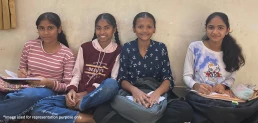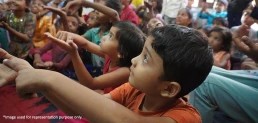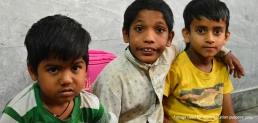- Understanding the Importance of STEM Education for Rural Children
- Top STEM Activities for Kids in Rural Areas
- Benefits of STEM Activities for Children in Rural Areas
- Challenges in Implementing STEM Education in Rural Areas
- How CRY America Can Help in Promoting STEM Activities in Rural Areas
- Frequently Asked Questions
In many rural communities across the world, children are full of curiosity and creativity. They ask endless questions about the world around them, and they learn by observing, experimenting, and playing. Yet, many of them lack access to quality education in science, technology, engineering, and mathematics, commonly known as STEM. By introducing STEM activities for kids, especially in rural areas, we can open up a world of possibilities that prepares them for the future while nurturing their natural love of learning.


Understanding the Importance of STEM Education for Rural Children
Why STEM Education Matters in Rural Communities
STEM education is not just for children in urban or well-resourced schools. In fact, it may be even more important for children in rural areas. STEM skills help children understand how things work, solve problems in their environment, and think creatively about the future. Imagine a child in a farming village learning about plant growth through a simple science experiment or using math to measure seeds. These small lessons build skills that are useful in their daily lives and also prepare them for modern careers.
Without access to STEM, children in rural areas often fall behind in education and career opportunities. Giving them hands-on learning experiences through STEM activities makes the subject exciting, practical, and relevant to their lives.
Top STEM Activities for Kids in Rural Areas
Not all STEM learning requires advanced laboratories or expensive tools. Many fun and educational projects can be done using everyday items found in rural households or schools. Here are some examples:
Simple Science Experiments for Kids in Rural Areas
Science experiments do not have to be complex to spark wonder. Children can learn the basics of chemistry, physics, and biology using simple items. For example:
- Mixing vinegar and baking soda to watch a fizzy reaction and learn about chemical changes.
- Growing plants in jars to understand photosynthesis and the role of sunlight and water.
- Creating a homemade water filter with sand, stones, and cloth to see how clean water is produced.
These activities help children see science as something alive and connected to their daily lives.
DIY Engineering Projects for Kids in Rural Areas
Engineering is about solving problems and building things. Even with limited resources, kids can take part in exciting hands-on projects:
- Constructing bridges or towers from sticks and string to test strength and balance.
- Making simple windmills or water wheels to explore renewable energy.
- Creating small boats from recycled bottles to test principles of buoyancy.
Such projects encourage teamwork, resilience, and problem-solving while teaching engineering concepts in a fun way.
Fun Technology-Based Learning Activities
While access to digital devices may be limited in rural areas, simple technology-based learning is still possible:
- Using solar-powered calculators to practice math and learn about renewable energy.
- Learning basic coding through offline games or card-based coding activities.
- Building simple circuits with batteries and bulbs to understand electricity.
These STEM activities for kids make technology feel approachable and help them develop a sense of innovation even without constant internet access.
Benefits of STEM Activities for Children in Rural Areas
Boosting Critical Thinking and Problem-Solving Skills
One of the biggest benefits of STEM activities is that they teach children how to think, not just what to think. When children experiment, test, and explore, they learn how to identify problems, come up with solutions, and try again if they fail. This way of thinking helps them both in school and in real life.
Encouraging Curiosity and Creativity
STEM sparks curiosity. A child who builds a simple windmill may start asking questions about how electricity reaches their home. This natural curiosity is the foundation of creativity. By encouraging exploration, STEM gives children the freedom to imagine and innovate.
Preparing Children for Future Careers in Technology and Innovation
The world is moving quickly toward technology-driven industries. Children in rural areas risk being left behind if they do not get exposure to these skills. Early experiences with STEM activities prepare them for future studies and careers in science, engineering, medicine, and technology. These opportunities can transform not just individual lives but entire communities.
Challenges in Implementing STEM Education in Rural Areas
Lack of Resources and Infrastructure
Many rural schools struggle with basic resources such as textbooks, classrooms, or trained teachers. This makes it even harder to introduce STEM education. Laboratories and equipment are often missing, and without proper tools, children may never get the chance to experience hands-on learning.
Overcoming the Digital Divide in Rural Communities
Technology has made STEM learning more interactive, but in many rural areas, there is limited or no access to the internet, computers, or digital tools. This digital divide creates an additional barrier for children. Bridging this gap requires creative approaches, like offline teaching tools, solar-powered devices, and training teachers to use low-cost resources effectively.
How CRY America Can Help in Promoting STEM Activities in Rural Areas
CRY America believes every child deserves the chance to learn, dream, and succeed, no matter their background. To make this possible, we work closely with children, communities, and multiple stakeholders to create lasting impact.
- Identify the Problem: Understand the challenges children face in rural areas and prioritize the most urgent educational needs.
- Partner with Local Communities: Collaborate with schools, local nonprofits, and volunteers to bring STEM activities into classrooms and communities.
- Provide Resources and Training: Equip teachers with training and simple, locally available materials, along with science kits, educational games, and solar-powered devices.
- Engage and Inspire Children: Encourage hands-on, community-based STEM projects that link learning to real-life challenges.
- Create Awareness and Mobilize Support: Raise awareness about the importance of STEM education and engage donors, media, and volunteers to support these initiatives.
By combining creativity, local resources, and collective action, CRY America helps rural children experience the joy of learning STEM and prepares them for a brighter future.
Frequently Asked Questions
Can STEM activities be done without access to technology?
Yes. Many STEM experiments use simple items like water, sand, leaves, or household tools. Technology is helpful, but creativity and curiosity are enough to start.
How can we overcome the lack of infrastructure for STEM activities in rural areas?
By using low-cost materials, training teachers, and promoting community-based projects, we can make STEM learning possible even without advanced labs.
Can STEM education be integrated with local knowledge and resources in rural areas?
Absolutely. Linking STEM with farming, local crafts, or water management makes it more relatable and practical for children.
What are some easy-to-do STEM projects that don’t require special tools or materials?
Building paper airplanes to test aerodynamics, creating patterns with leaves, or making simple pulleys with string and stones are all fun, effective projects.
Recommended for you
























